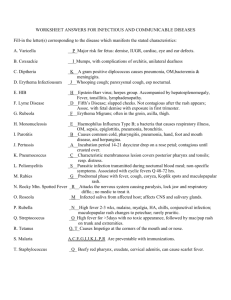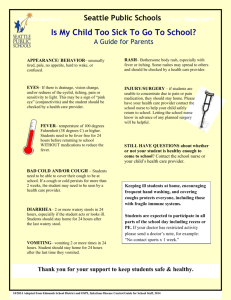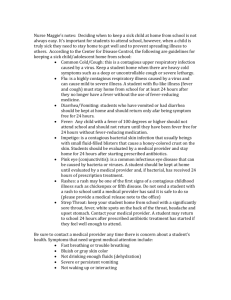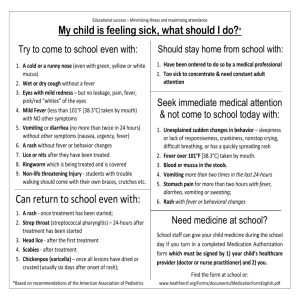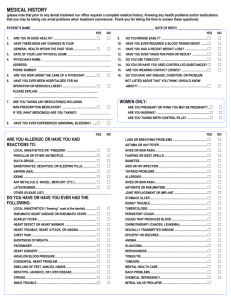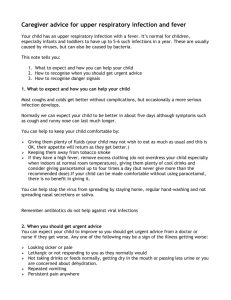Is Your Child Too Sick For School
advertisement
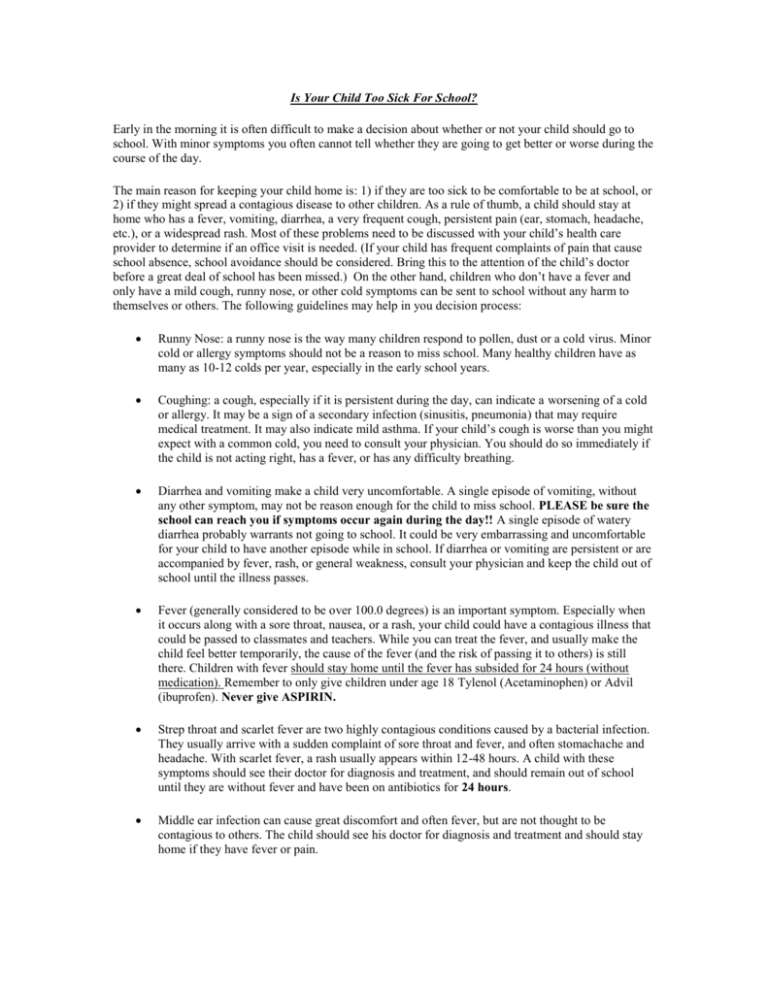
Is Your Child Too Sick For School? Early in the morning it is often difficult to make a decision about whether or not your child should go to school. With minor symptoms you often cannot tell whether they are going to get better or worse during the course of the day. The main reason for keeping your child home is: 1) if they are too sick to be comfortable to be at school, or 2) if they might spread a contagious disease to other children. As a rule of thumb, a child should stay at home who has a fever, vomiting, diarrhea, a very frequent cough, persistent pain (ear, stomach, headache, etc.), or a widespread rash. Most of these problems need to be discussed with your child’s health care provider to determine if an office visit is needed. (If your child has frequent complaints of pain that cause school absence, school avoidance should be considered. Bring this to the attention of the child’s doctor before a great deal of school has been missed.) On the other hand, children who don’t have a fever and only have a mild cough, runny nose, or other cold symptoms can be sent to school without any harm to themselves or others. The following guidelines may help in you decision process: Runny Nose: a runny nose is the way many children respond to pollen, dust or a cold virus. Minor cold or allergy symptoms should not be a reason to miss school. Many healthy children have as many as 10-12 colds per year, especially in the early school years. Coughing: a cough, especially if it is persistent during the day, can indicate a worsening of a cold or allergy. It may be a sign of a secondary infection (sinusitis, pneumonia) that may require medical treatment. It may also indicate mild asthma. If your child’s cough is worse than you might expect with a common cold, you need to consult your physician. You should do so immediately if the child is not acting right, has a fever, or has any difficulty breathing. Diarrhea and vomiting make a child very uncomfortable. A single episode of vomiting, without any other symptom, may not be reason enough for the child to miss school. PLEASE be sure the school can reach you if symptoms occur again during the day!! A single episode of watery diarrhea probably warrants not going to school. It could be very embarrassing and uncomfortable for your child to have another episode while in school. If diarrhea or vomiting are persistent or are accompanied by fever, rash, or general weakness, consult your physician and keep the child out of school until the illness passes. Fever (generally considered to be over 100.0 degrees) is an important symptom. Especially when it occurs along with a sore throat, nausea, or a rash, your child could have a contagious illness that could be passed to classmates and teachers. While you can treat the fever, and usually make the child feel better temporarily, the cause of the fever (and the risk of passing it to others) is still there. Children with fever should stay home until the fever has subsided for 24 hours (without medication). Remember to only give children under age 18 Tylenol (Acetaminophen) or Advil (ibuprofen). Never give ASPIRIN. Strep throat and scarlet fever are two highly contagious conditions caused by a bacterial infection. They usually arrive with a sudden complaint of sore throat and fever, and often stomachache and headache. With scarlet fever, a rash usually appears within 12-48 hours. A child with these symptoms should see their doctor for diagnosis and treatment, and should remain out of school until they are without fever and have been on antibiotics for 24 hours. Middle ear infection can cause great discomfort and often fever, but are not thought to be contagious to others. The child should see his doctor for diagnosis and treatment and should stay home if they have fever or pain. A virus, bacteria, or allergy can cause pink eye. The first two are very contagious. The eye will be reddened, and a cloudy or yellow discharge is usually present. The eye may be sensitive to light. Consult with you child’s doctor to see if antibiotics are needed. Again, the child should stay at home until symptoms subside and they have been on antibiotics at least 24 hours. Flu is a contagious virus that usually occurs in the winter months. Symptoms include body aches, high fever, chills, congestion, sore throat, and in some children, vomiting. The child should stay at home until these symptoms subside, usually 5-7 days. Consult your child’s doctor for treatment suggestions to make your child more comfortable. Impetigo is a staph or strep infection that creates a red, oozing blister-like rash that can appear anywhere on the body or face. It can be passed to others by contact. The most effective preventive measure is good personal hygiene, bathing with soap and water. Students with Impetigo should remain at home for 24 hours after beginning antibiotic treatment. Infected area should be covered if possible. Chicken pox (VERY RARE TODAY) is a highly contagious viral illness. It causes fever and an itchy rash, which spreads quickly all over the body, changing from red bumps to blister-like lesions, then scabs. The child will need to stay home until all bumps are dry and no new bumps have appeared for two days. Your child is contagious at least two days before the rash starts, so you need to let the school know, and consult your doctor for symptomatic treatment. A vaccine is now available for children and is required for all children who have not yet had chicken pox. Mites and lice brought into a school can quickly produce an epidemic of itching and scratching. Mites are tiny insects that burrow into the skin and cause severe itching. Lice are tiny parasites, like ticks, that thrive on the warm scalp of children and also cause itching. Both should be treated immediately, with advice from your doctor. In the case of head lice, until all nits and eggs should removed from the head to reduce the likelihood of reinfestations. Head checks should continue at home for 10-14 days. Caution your child against sharing combs, brushes, hats, or other clothing. Ringworm is a contagious fungus infection that can affect the scalp, the body (particularly the groin), the feet and nails. Despite its name, it has nothing to do with worms. The name comes from the characteristic red ring that can appear on an infected person’s skin. Ringworm can be treated with fungus-killing medicine. The medicine can be taken in tablet or liquid form by mouth for scalp infections or as a cream applied directly to the affected area on the body, covered with a Band-Aid. The child should remain at home until treatment has begun. Lack of or inadequate treatment can result in an infection that will not clear up. All of these illnesses can be easily spread, both in school and at home. Keep in mind that hand washing is the single most important thing you can teach your child to do that will help prevent the spread of infections. Whenever there is doubt in your mind about sending your child to school, consult your child’s doctor before doing so. A phone consultation may be all that is necessary, or your doctor may need to see the child in the office. Remember to always make sure that the school knows how to reach you during the day, and that there is a back up plan and phone number on file if they cannot reach you. This is an information sheet only and is not meant to be used for diagnosis or as a substitute for consultation with your health care provider. If you have any questions about your child’s illness contact your health care provider. Please keep the office informed of your child’s health conditions as they arise. Thank you for helping to keep our school a healthy place to be!
